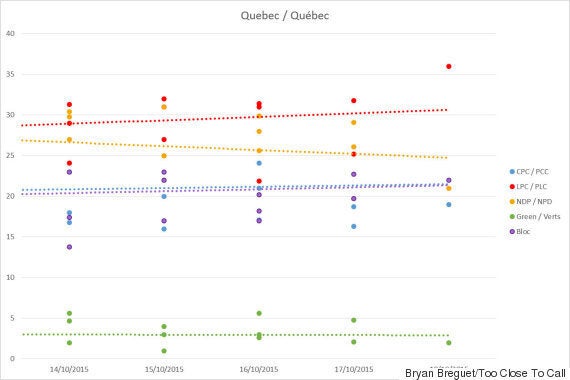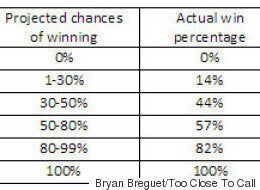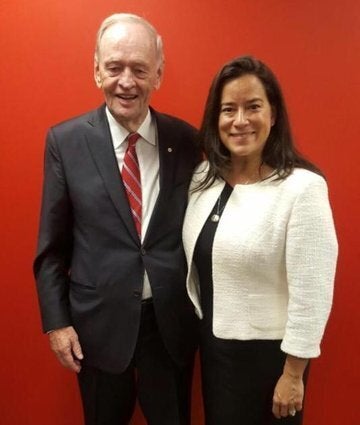Monday’s election brought us a stunning result with a Liberal majority beyond what even the most optimistic could have expected or predicted.
While polls did well at the national level (although they did slightly underestimate the Conservatives, as we anticipated), seat projections didn’t fare particularly well, and we have a lot of things to analyze.
However, let’s not make the mistake of thinking that just because something happened, it was the most likely scenario.
The fact is: a Liberal majority was unlikely. We had this scenario as the third most likely, behind a Liberal minority and even a Conservative minority. And we weren’t alone.
Paul Fairie at The Globe and Mail also had the same three scenarios in the same order — albeit with different probabilities attached to them. Pierre Martin had very similar predictions for the Journal de Montréal. The consensus was that a Liberal minority was by far the most likely outcome.
So, how did the Liberals get their majority? A comfortable one at that. There are essentially two answers: a late surge in Quebec not picked up by the polls and really good vote efficiency, particularly in Ontario.
Here are the polls in Quebec during the last week of the campaign, including the two last-minute polls of Nanos and Forum. They are displayed by the mid-date of when the data were collected.

As a reminder, the Liberals won Quebec with 35.7 per cent of the vote, ahead of the NDP’s 25.4, the Bloc’s 19.3 and the Tories’ 16.7. Only the last minute poll by Forum was actually close for the Liberals, but it was clearly off for the NDP. Let’s also not forget that it was based on only 278 observations, which means we couldn’t have seen this poll and based our projections entirely on it.
In average, the Liberals were ahead by a couple of points, not the 10 that they actually received. Even Nanos, who was so close nationally, had the Liberals up by only two points in its last poll on Sunday. Of course, margins of error were wide, but the average was still off, even though we could argue that the trends were there.
This last minute shift gave the Liberals significantly more seats in Quebec than projected. They actually won the province with 40 seats, a first since the Bloc was founded in the early '90s. They generated a good 15 additional seats, which carried them that much closer to a majority.
The rest had to come from vote efficiency, since the polls didn’t miss the other provinces by much. A couple came from surprising wins here and there (for instance, taking St. John’s East in Newfoundland) thanks most likely to a good Liberal machine (probably influenced by the Obama campaign in 2012). And, of course, there is Ontario.
In that province, polls were actually pretty accurate and correctly predicted the Liberals ahead by about 10 points (45 to 35). The seat count, however, heavily went in the Liberals’ favour.
With the Liberals’ capture of 80 seats out of 121, the Tories had to settle for 33 while the NDP got wiped out of Toronto and managed to elect only eight MPs for Ontario.
This is where the seat projection model mostly failed. And this is where we need to look to see what could have been done. The collapse of the NDP vote helped a lot, allowing the Liberals to win ridings that we didn’t think they would. It’s too early to clearly tell if 80 seats in Ontario was actually a scenario that should have been predicted.
It should be said, however, that no candidate projected with a zero per cent chance of winning ultimately got elected. The simulations and probabilities were actually spot on, as is shown in the table below.

What this tells us is that the Liberals won a majority simply by winning unlikely seats, mostly at the expense of relatively safe NDP ones. It also shows that the uncertainty associated with projections for 338 ridings based on a couple of provincial numbers is high.
We tried our best to represent and display this uncertainty, but we could probably have done more. We see, however, that missing one province’s results can make a big difference. For the record, using the actual results of the election, our model would have projected 170 Liberals, 115 Conservatives and 50 NDP. This is already a lot closer, but it still shows the Liberals winning seats we wouldn’t have projected.
There is no doubt that this Liberal triumph will be studied in depth — in particular by the other parties as they try to figure out what the Grits did so right to win so many more seats seats than expected.
Bryan Breguet has a B.Sc in economics of politics and a M.sc in economics from the University of Montreal. He founded TooCloseToCall.ca in 2010 where he provides electoral analysis and projections. He has collaborated with the National Post, Journal de Montréal and l’Actualité.
He provided analysis and updates for The Huffington Post Canada throughout the federal election campaign. For riding by riding projections, visit his interactive simulator.

Also on HuffPost
